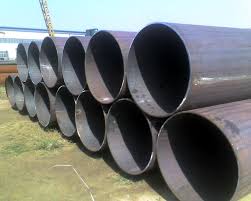What is ERW steel pipe?
ERW welded tube (Electrical Resistance Welded Steel Pipe, referred to as ERW) is a hot-rolled coil formed by a forming machine. The skin effect and proximity effect of high-frequency current are used to heat and melt the edge of the tube blank under the action of the extrusion roller. Pressure welding is performed to achieve production.
ERW steel pipes are manufactured through low-frequency or high-frequency resistance "resistance". They are round tubes with longitudinal welds welded from steel plates. ERW steel pipes are used to transport gas and liquid objects such as oil and natural gas, and can meet various high and low pressure requirements. At present, ERW steel pipes occupy a pivotal position in the world's transportation pipeline field.

What does ERW mean in welding?
Electric resistance welding (ERW) is a welding process where metal parts in contact are permanently joined by heating them with an electric current, melting the metal at the joint.
How is ERW pipe made?
Manufacturing Process of ERW steel pipe
ERW pipe is manufactured by cold forming a flat steel strip into a rounded tube and passing it through a series of forming rollers to obtain a longitudinal seam. The two edges are then simultaneously heated with a high frequency current and squeezed together to form a bond. The longitudinal ERW seam does not require filler metal.
Standards of erw steel pipe
Sizes of erw steel pipe
Out diameter: 1/2" -24" (21.3mm-610mm)
Wall thickness: 1.65mm-20mm
Where ERW pipes are used?
ERW straight seam welded pipes are mainly used in water supply projects, petrochemical industry, chemical industry, electric power industry, agricultural irrigation, and urban construction.
(1) For liquid transportation: water supply and drainage.
(2) For gas transportation: coal gas, steam, liquefied petroleum gas.
(3) Structural use: used as piling pipes, bridges; pipes for docks, roads, building structures, etc.
ERW welded tube (Electrical Resistance Welded Steel Pipe, referred to as ERW) is a hot-rolled coil formed by a forming machine. The skin effect and proximity effect of high-frequency current are used to heat and melt the edge of the tube blank under the action of the extrusion roller. Pressure welding is performed to achieve production.
ERW steel pipes are manufactured through low-frequency or high-frequency resistance "resistance". They are round tubes with longitudinal welds welded from steel plates. ERW steel pipes are used to transport gas and liquid objects such as oil and natural gas, and can meet various high and low pressure requirements. At present, ERW steel pipes occupy a pivotal position in the world's transportation pipeline field.

What does ERW mean in welding?
Electric resistance welding (ERW) is a welding process where metal parts in contact are permanently joined by heating them with an electric current, melting the metal at the joint.
How is ERW pipe made?
Manufacturing Process of ERW steel pipe
ERW pipe is manufactured by cold forming a flat steel strip into a rounded tube and passing it through a series of forming rollers to obtain a longitudinal seam. The two edges are then simultaneously heated with a high frequency current and squeezed together to form a bond. The longitudinal ERW seam does not require filler metal.
Standards of erw steel pipe
| ERW Pipe | |
| ASTM | ASTM A53 B, ASTM A178, ASTM A252 GR.2, A500, ASTM A513 |
| API | API 5L X42/46/52/56/60/70 |
| EN | EN 10204/10217 S235JR,S275JR,S355,S355JR,S355J2H |
Sizes of erw steel pipe
Out diameter: 1/2" -24" (21.3mm-610mm)
Wall thickness: 1.65mm-20mm
Where ERW pipes are used?
ERW straight seam welded pipes are mainly used in water supply projects, petrochemical industry, chemical industry, electric power industry, agricultural irrigation, and urban construction.
(1) For liquid transportation: water supply and drainage.
(2) For gas transportation: coal gas, steam, liquefied petroleum gas.
(3) Structural use: used as piling pipes, bridges; pipes for docks, roads, building structures, etc.









